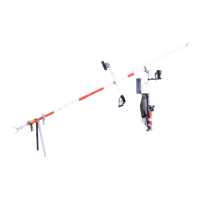Installation Manual _________________________________________________________________
44 __________________________________________________________________ M210485EN-B
In areas of homogeneous dense vegetation, the height of the
vegetation should be kept below the gauge orifice level by regular
mowing. Sites on a slope or on the roof of a building should be
avoided. Also hard flat surfaces such as concrete should be avoided to
prevent excessive in-splashing.
Lightning Detection
SA20M Lightning Detector is installed on the sensor arm of the mast.
The main siting consideration for the SA20M sensor is interference
from local obstructions. Any conducting object, except the pole mast,
that presents a profile of approximately 30 degrees, or more, above the
horizon of the antenna ground plane is an obstruction. For a metal
building (very wide, solid metallic wall) that is 9 m (30 feet) taller
than the mounted height of SA20M, the sensor should be placed at
least 18 m (60 feet) away. Refer to Figure 31 below.
9904-024
Figure 31 SA20M Vertical Obstruction (Side View)
Horizontal obstructions do not greatly effect the detection efficiency
of SA20M. However, it is desirable to have no obstructions to the
sensor. The horizontal angle obstructed by an object should not be
greater than 5 degrees; larger angles than this will affect accurate
reporting of strike bearing in the direction of the object as shown in
Figure 32 on page 45. The size of the obstruction dictates the degree
of the inaccuracy.

